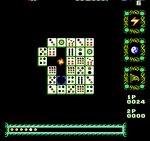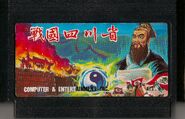No edit summary Tag: rte-source |
No edit summary |
||
| (10 intermediate revisions by 5 users not shown) | |||
| Line 1: | Line 1: | ||
{{Infobox game |
{{Infobox game |
||
| − | | |
+ | |name = Zhan Guo Si Chuan Sheng |
| − | | |
+ | |image = File:Tof ch t.png |
| − | | |
+ | |imagewidth = 250px |
| − | | |
+ | |caption = Title screen. |
| − | | |
+ | |publisher = [[Idea-Tek]], [[Computer & Entertainment|C&E]], [[American Video Entertainment|AVE]], [[Hacker International]], Milmar |
| − | | |
+ | |developer = Computer & Entertainment |
| − | | |
+ | |cartid = ET.05 |
| − | | |
+ | |console = Famicom |
| − | | |
+ | |date = 1990 |
| − | | |
+ | |price = |
| − | | |
+ | |engine = |
| − | | |
+ | |sound = Guo Qiyong |
| − | | |
+ | |alt = ''Tiles of Fate''<br>''Idol Shisen Mahjong'' |
}} |
}} |
||
'''''Zhan Guo Si Chuan Sheng''''' (戰國四川省), also known as '''''Tiles of Fate''''', is a Famicom game based on Shisen-sho, a mahjong solitaire game. It was developed by [[Computer & Entertainment]], released first by [[Idea-Tek]] then C&E themselves in Taiwan, [[American Video Entertainment]] in North America and [[Hacker International]] in Japan. |
'''''Zhan Guo Si Chuan Sheng''''' (戰國四川省), also known as '''''Tiles of Fate''''', is a Famicom game based on Shisen-sho, a mahjong solitaire game. It was developed by [[Computer & Entertainment]], released first by [[Idea-Tek]] then C&E themselves in Taiwan, [[American Video Entertainment]] in North America and [[Hacker International]] in Japan. |
||
== Overview == |
== Overview == |
||
| − | [[File: |
+ | [[File:Tof gameplay2.png|150px|thumb|left|Gameplay (Stage 1-1).]] |
The goal of the game is to conquer back the districts of Mainland China by completing the 21 boards split across 7 levels. To clear a board, all pairs must be joined in less than 3 turns before the time runs out. Pairing 2 pieces refills the time bar by 2 dots (about 6 seconds). After completing 3 boards, a cutscene shows a warrior entering a fortress and replacing the flags of the conquered district. |
The goal of the game is to conquer back the districts of Mainland China by completing the 21 boards split across 7 levels. To clear a board, all pairs must be joined in less than 3 turns before the time runs out. Pairing 2 pieces refills the time bar by 2 dots (about 6 seconds). After completing 3 boards, a cutscene shows a warrior entering a fortress and replacing the flags of the conquered district. |
||
| Line 24: | Line 24: | ||
=== ''Tiles of Fate'' === |
=== ''Tiles of Fate'' === |
||
| − | Released in 1990 by |
+ | Released in 1990 by American Video Entertainment under license by C&E, this release features an English title screen and rewritten text for the cutscenes, the original containing poor grammar. |
=== ''Idol Shisen Mahjong'' === |
=== ''Idol Shisen Mahjong'' === |
||
| − | An advanced hack made and published at an unknown date by |
+ | An advanced hack made and published at an unknown date by Hacker International supposedly under license by C&E. The setting was changed for the publisher's need; instead of reconquering China, the player tries to win against a girl to undress her gradually. After 5 rounds (6 for the second one), the player is awarded with a partial nude picture. There are 4 different girls likely named after popular idols from 1990. The mechanics of the game and graphics for the tiles remains untouched. All the music was changed however. |
== Staff == |
== Staff == |
||
| Line 38: | Line 38: | ||
== Gallery == |
== Gallery == |
||
| ⚫ | |||
<gallery> |
<gallery> |
||
| − | ET05-A.jpg|Original release (Idea-Tek) |
+ | ET05-A.jpg|Original release (Idea-Tek). |
</gallery> |
</gallery> |
||
| ⚫ | |||
== Trivia == |
== Trivia == |
||
| Line 49: | Line 49: | ||
{{American Video Entertainment Games}} |
{{American Video Entertainment Games}} |
||
| + | [[Category:Games]] |
||
[[Category:Famicom/NES games]] |
[[Category:Famicom/NES games]] |
||
[[Category:Puzzle games]] |
[[Category:Puzzle games]] |
||
| + | [[Category:Hacker International]] |
||
| + | [[Category:1990 video games]] |
||
Latest revision as of 20:13, 24 January 2020
Zhan Guo Si Chuan Sheng (戰國四川省), also known as Tiles of Fate, is a Famicom game based on Shisen-sho, a mahjong solitaire game. It was developed by Computer & Entertainment, released first by Idea-Tek then C&E themselves in Taiwan, American Video Entertainment in North America and Hacker International in Japan.
Overview

Gameplay (Stage 1-1).
The goal of the game is to conquer back the districts of Mainland China by completing the 21 boards split across 7 levels. To clear a board, all pairs must be joined in less than 3 turns before the time runs out. Pairing 2 pieces refills the time bar by 2 dots (about 6 seconds). After completing 3 boards, a cutscene shows a warrior entering a fortress and replacing the flags of the conquered district.
Versions
Zhan Guo Si Chuan Sheng had 3 different releases: the original, one in North America by AVE and yet another one by Hacker International with some slight changes.
Tiles of Fate
Released in 1990 by American Video Entertainment under license by C&E, this release features an English title screen and rewritten text for the cutscenes, the original containing poor grammar.
Idol Shisen Mahjong
An advanced hack made and published at an unknown date by Hacker International supposedly under license by C&E. The setting was changed for the publisher's need; instead of reconquering China, the player tries to win against a girl to undress her gradually. After 5 rounds (6 for the second one), the player is awarded with a partial nude picture. There are 4 different girls likely named after popular idols from 1990. The mechanics of the game and graphics for the tiles remains untouched. All the music was changed however.
Staff
- Director: Jack YEH
- Planned by: Tricia CHEN
- Programmer: Ho YU-HWA
- Graphics: Kathy CHEN
- Composer: B.H. TING
- Special Thanks: Harry JEAN, Daru YOUNG, Yeh MIN-HWA
Gallery
- Main article: Zhan Guo Si Chuan Sheng/gallery
Trivia
- This is C&E's first game.
- There is a stage select cheat for each versions of the game. On Zhan Guo Si Chuan Sheng and Tiles of Fate at the stage number screen, press in order: Select, A, A, B, B, B, A, A, B, B, B, A, B, A, B. When entered correctly, a sound will play and pressing A or B will let you select the stage. In Idol Shisen Mahjong at the same screen, simply press in order Select, A, B. Press Start to see the stage picture. When returning to the stage number screen, press Start again to play the stage.
- The original Idea-Tek cartridges are actually individually numbered on the top sticker.
| List of games by American Video Entertainment |
|---|
|
Backgammon · Big Mouth Bass · Blackjack · Cue Stick · Deathbots · Double Strike · Dudes with Attitude · F-15 City War · Krazy Kreatures · Maxivision 15-in-1 · Mermaids of Atlantis · Poker · Puzzle · Pyramid · Rad Racket: Tennis Deluxe II · Solitaire · Tiles of Fate · Trolls on Treasure Island · Ultimate League Soccer · Venice Beach Volleyball · Wally Bear and the NO! Gang |

